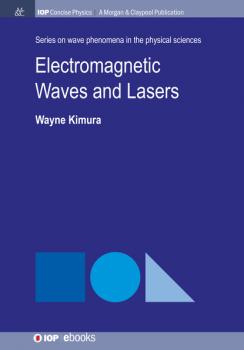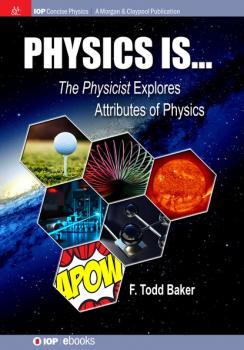IOP Concise Physics
Скачать книги из серии IOP Concise PhysicsThe Mössbauer Effect
The effect which now bears his name, was discovered in 1958 by Rudolf Mössbauer at the Technical University of Munich. At first, this appeared to be a phenomenon related to nuclear energy levels that provided some information about excited state lifetimes and quantum properties. However, it soon became apparent that Mössbauer spectroscopy had applications in such diverse fields as general relativity, solid state physics, chemistry, materials science, biology, medical physics, archeology and art. It is the extreme sensitivity of the effect to the atomic environment around the probe atom as well as the ability to apply the technique to some interesting and important elements, most notably iron, that is responsible for the Mössbauer effect's extensive use. The present volume reviews the historical development of the Mössbauer effect, the experimental details, the basic physics of hyperfine interactions and some of the numerous applications of Mössbauer effect spectroscopy.
Electromagnetic Waves and Lasers
This book reviews basic electromagnetic (EM) wave theory and applies it specifically to lasers in order to give the reader not only tangible examples of how the theory is manifested in real life, but also practical knowledge about lasers, and their operation and usage. The latter can be useful for those involved with using lasers. As a short treatise on this subject matter, this book is not intended to dwell deeply into the details of EM waves nor lasers. A bibliography is provided for those who wish to explore in more depth the topics covered in this book. Rather the aim of this book is to offer a quick overview, which will allow the reader to gain a competent general understanding of EM waves and lasers.
Applied Digital Logic Exercises Using FPGAs
FPGAs have almost entirely replaced the traditional Application Specific Standard Parts (ASSP) such as the 74xx logic chip families because of their superior size, versatility, and speed. For example, FPGAs provide over a million fold increase in gates compared to ASSP parts. The traditional approach for hands-on exercises has relied on ASSP parts, primarily because of their simplicity and ease of use for the novice. Not only is this approach technically outdated, but it also severely limits the complexity of the designs that can be implemented. By introducing the readers to FPGAs, they are being familiarized with current digital technology and the skills to implement complex, sophisticated designs. However, working with FGPAs comes at a cost of increased complexity, notably the mastering of an HDL language, such as Verilog. Therefore, this book accomplishes the following: first, it teaches basic digital design concepts and then applies them through exercises; second, it implements these digital designs by teaching the user the syntax of the Verilog language while implementing the exercises. Finally, it employs contemporary digital hardware, such as the FPGA, to build a simple calculator, a basic music player, a frequency and period counter and it ends with a microprocessor being embedded in the fabric of the FGPA to communicate with the PC. In the process, readers learn about digital mathematics and digital-to-analog converter concepts through pulse width modulation.
Radiative Properties of Semiconductors
Optical properties, particularly in the infrared range of wavelengths, continue to be of enormous interest to both material scientists and device engineers. The need for the development of standards for data of optical properties in the infrared range of wavelengths is very timely considering the on-going transition of nano-technology from fundamental R&D to manufacturing. Radiative properties play a critical role in the processing, process control and manufacturing of semiconductor materials, devices, circuits and systems. The design and implementation of real-time process control methods in manufacturing requires the knowledge of the radiative properties of materials. Sensors and imagers operate on the basis of the radiative properties of materials. This book reviews the optical properties of various semiconductors in the infrared range of wavelengths. Theoretical and experimental studies of the radiative properties of semiconductors are presented. Previous studies, potential applications and future developments are outlined. In Chapter 1, an introduction to the radiative properties is presented. Examples of instrumentation for measurements of the radiative properties is described in Chapter 2. In Chapters 3-11, case studies of the radiative properties of several semiconductors are elucidated. The modeling and applications of these properties are explained in Chapters 12 and 13, respectively. In Chapter 14, examples of the global infrastructure for these measurements are illustrated.
Concepts in Physical Metallurgy
The progress of civilization can be, in part, attributed to their ability to employ metallurgy. This book is an introduction to multiple facets of physical metallurgy, materials science, and engineering. As all metals are crystalline in structure, it focuses attention on these structures and how the formation of these crystals are responsible for certain aspects of the material's chemical and physical behaviour. Concepts in Physical Metallurgy also discusses the mechanical properties of metals, the theory of alloys, and physical metallurgy of ferrous and non-ferrous alloys.
Outside the Research Lab, Volume 1
This book is written for students and other interested readers as a look inside the diverse range of applications for physics outside of the scientific research environment. This first volume covers several different areas of the arts and design ranging from stage lighting to sculpting. The author has interviewed experts in each area to explain how physics and technology impact their work. These are all useful examples of how physics encountered in taught courses relates to the real world.
Physics is…
He's back! The physicist returns with an entirely new compilation of questions and answers from his long-lived website where laypeople can ask questions about anything physics related. This book focuses on adjectives (practical, beautiful, surprising, cool, frivolous) instead of nouns like the first two books (atoms, photons, quanta, mechanics, relativity). The answers within 'Physics Is' are responses to people looking for answers to fascinating (and often uninformed) questions. It covers topics such as sports, electromagnetism, gravitational theory, special relativity, superheroes, videogames, and science fiction. These books are designed for laypeople and rely heavily on concepts rather than formalism. That said, they keep the physics correct and don't water down, so expert physicists will find this book and its two companion titles fun reads. They may actually recognize similar questions posed to them by friends and family. As with the first two books, 'Physics Is' ends with a chapter with questions from people who think that 'The physicist' is a psychic and from people who think they have the answers to life, the universe and everything.
A Handbook of Mathematical Methods and Problem-Solving Tools for Introductory Physics
This is a companion textbook for an introductory course in physics. It aims to link the theories and models that students learn in class with practical problem-solving techniques. In other words, it should address the common complaint that 'I understand the concepts but I can't do the homework or tests'. The fundamentals of introductory physics courses are addressed in simple and concise terms, with emphasis on how the fundamental concepts and equations should be used to solve physics problems.
Introduction to Cellular Biophysics, Volume 2
All living matter is comprised of cells, small compartments isolated from the environment by a cell membrane and filled with concentrated solutions of various organic and inorganic compounds. Some organisms are single-cell, where all life functions are performed by that cell. Others have groups of cells, or organs, specializing in one particular function. The survival of the entire organism depends on all of its cells and organs fulfilling their roles. While the cells are studied by different sciences, they are seen differently by biologists, chemists, or physicists. Biologists concentrate their attention on cell structure and function. What the cells consists of? Where are its organelles? What function each organelle fulfils? From a chemists’ point of view, a cell is a complex chemical reaction chamber where various molecules are synthesized or degraded. The main question is how these, sometimes very complicated chains of reactions are controlled. Finally, from a physics standpoint, some of the fundamental questions are about the physical movement of all these molecules between organelles within the cell, their exchange with the extracellular medium, as well as electrical phenomena resulting from such transport. The aim of this book is to look into the basic physical phenomena occurring in cells. These physical transport processes facilitate chemical reactions in the cell and various electrical effects, and that in turn leads to biological functions necessary for the cell to satisfy its role in the mother organism. Ultimately, the goals of every cell are to stay alive and to fulfill its function as a part of a larger organ or organism. The first volume of this book is an inventory of physical transport processes occurring in cells while this second volume provides a closer look at how complex biological and physiological cell phenomena result from these very basic physical processes.
Measuring Nothing, Repeatedly
There have been many recent discussions of the 'replication crisis' in psychology and other social sciences. This has been attributed, in part, to the fact that researchers hesitate to submit null results and journals fail to publish such results. In this book Allan Franklin and Ronald Laymon analyze what constitutes a null result and present evidence, covering a 400-year history, that null results play significant roles in physics.









